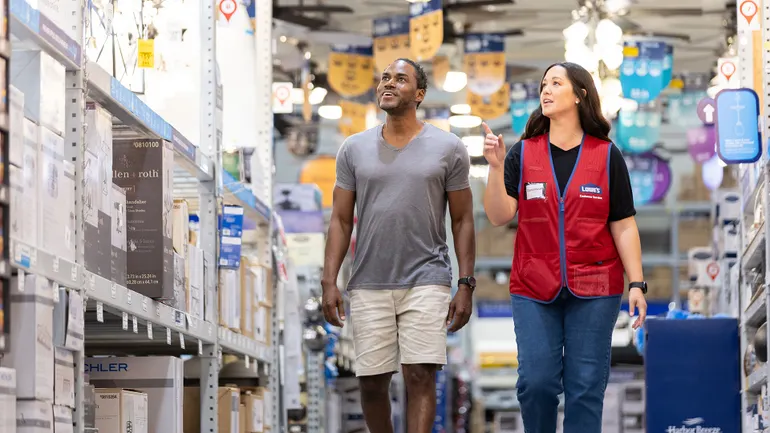Listen to the article
As part of its broader business transformation strategy, Lowe’s is using AI to drive market share, improve experiences and unlock efficiencies.
The company is no stranger to the technology — partnering with OpenAI nearly a year before ChatGPT launched — but Lowe’s is especially bullish on AI’s value as more applications go into production and internal access expands, according to Chandhu Nair, senior vice president of AI, data and innovation at Lowe’s.
“Generative AI really addressed a big white space opportunity, especially in home improvement,” Nair told sister publication CIO Dive. “We had the problem that probably every company had: 300-plus use cases coming from everywhere.”

Chandhu Nair, senior vice president of AI, data and innovation at Lowe’s.
Permission granted by Lowe’s
When honing its AI approach for the year, the company aligned its plans with its broader 2025 growth goals, dubbed the Total Home Strategy. Lowe’s identified areas where leaders thought AI could help, anchored to shopping, selling and working experiences. From there, the company has pursued its top-tier use cases with the highest value.
One of the key pillars of the company’s AI journey has been connecting with stakeholders and building feedback loops throughout the process to improve the usefulness of systems and ensure they’re working as expected.
After all, successful adoption isn’t possible without end users engaging with the tools and technology. Creating tools that actually help employees rather than pushing applications for the sake of technology is critical, as nearly half of CEOs say employee resistance and hostility to AI is a challenge, according to a Kyndryl survey.
“One thing that we do consistently as an AI team is we are on the floor,” Nair said. “You cannot be an AI engineer or a data scientist on our teams unless you’re walking the floor and seeing the tools in action.”
Engineers who interact with associates on the floor are better able to troubleshoot problems and understand how future roadmaps should be shaped, Nair said.
Earlier this summer, the home improvement retailer gave associates across its more than 1,700 stores access to an internal AI assistant called Mylow Companion, and released a similar customer-facing tool.
With each response, the Mylow tool has a thumbs up and down button for quick feedback, which is monitored daily. Teams also keep track of a number of other usage metrics. Through this monitoring, engineers realized that associates were much more likely to use even a glitchy version of voice-to-text rather than typing words in.
“If you have a customer in front of you, you don’t want to be looking down on the phone and typing, so they were using the voice feature, which had problems, so we quickly pivoted [to improve it],” Nair said. “There’s a whole host of nuances and things when it comes to voice-enabled AI.”
The on-the-ground perspective and connection with stakeholders resulted in the tool being a bigger asset to associates and improved the intersection of employee and customer experiences.
Measuring value and ROI
In addition to its flagship assistant-style use cases, Lowe’s is leveraging AI across its business at different stages of maturity, from marketing to search capabilities on its website. The company also sees AI as a lever in its enterprisewide productivity push, which it hopes will generate around $1 billion in annual cost savings.
Knowing which use cases to pursue and scale is crucial to the business’ broader success as AI becomes intertwined in various processes. Lowe’s tech teams use a framework, created in collaboration with finance partners, to get a sense of how a project is going.
“We broke it down to what we call our leading indicators and our lagging indicators,” Nair said. Lagging indicators are the expected financial outcomes, such as revenue growth or conversion uplift. Leading indicators are adoption rates, how many times a day employees use the tool, weekly active user reports and the feedback metrics.
“What we do with each of these is try to make sure that adoption and positive feedback and ratings continue to go up, because that is really what will drive the sales uplift,” Nair said. “If they are not healthy, we quickly pivot and say, ‘Do we need to do a test, recalibrate, change or in some cases kill it?’”
Each use case has pre-established indicators and metrics that are tracked and monitored on a weekly basis.
To ensure projects have a fighting chance, the company has also put a lot of effort into AI literacy. Lowe’s developed a tailored training program with help from partners, including OpenAI and Google. Starting with the C-suite and down to the associate level, everyone has gone through some level of AI upskilling, including Nair.
“You’ve got to make people be part of this transformation, otherwise it’s not going to succeed,” Nair said, recommending technology leaders:
Decide where to build or partner
Lean into a platform strategy that hedges the business from the model and capability race
Level up everyone’s understanding of how to use and approach AI
“You’ve got to think about this as a business transformation rather than a technology shift,” Nair said. “If you just use generative AI to address holes, it’s an expensive tool, but if you can really reimagine the business and apply AI, then it can be your leapfrog opportunity.”


